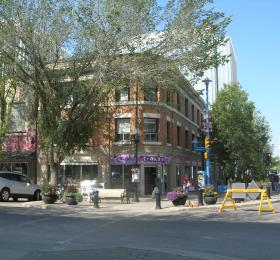Laurentian/Union Bank
- Regular
Description of the Historic Place
The Laurentian / Union Bank (also known as the Pinder Block) is a two-storey stone and brick building that was constructed in 1909. Located on the corner of 2nd Avenue South and 21st Street East at 283 2nd Avenue South, the Laurentian / Union Bank features Classical Revival architectural influences, and is a prominent architectural and historical feature of Saskatoon’s downtown.
Heritage Value
The Laurentian / Union Bank was the second chartered bank in Saskatoon. Designed by architects Brown and Vallance, whose work also includes some of the early University of Saskatchewan buildings, the Laurentian / Union Bank Building exhibits Classical Revival architectural influences. The building is characterized by a low profile, rounded corners, and Grecian-style dentil moulds under the cornice. At the time of its construction, the main entrance was ornamented with fluted columns with carved Ionic capitals. Inside the building, the main banking room and vestibule were floored with Italian marble and all office fittings were in mahogany and oxidized copper.
Many changes have been made to the Laurentian / Union Bank Building since its construction, including the windows and lower floors. Alterations in the 1920s, when the ceiling on the main floor was lowered, resulted in an extra level without raising the roof. The bank premises were also subdivided in the 1920s resulting in a number of different businesses including Tip Top Tailors, Pinder's Drugstore, United Cigar Stores, The Nut House, Cinderella Style Shop, Fur Town and Fran's Gifts & Souvenirs.
Although the interior of the building has been updated, the exterior has retained much of its original character. In 1993, the Laurentian / Union Bank Building received a City of Saskatoon Heritage Award for the sympathetic renovation of a commercial building.
Source: City of Saskatoon Built Heritage Database
Character Defining Elements
Key elements which contribute to the heritage value of this historic resource include:
- Its architectural style with Classical Revival influences, evident in: its brick and stone low profile façade, rounded corners, cornice and Grecian-style dentil moulds.

